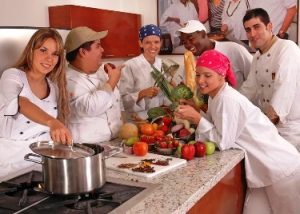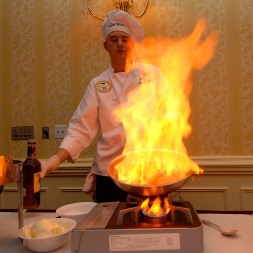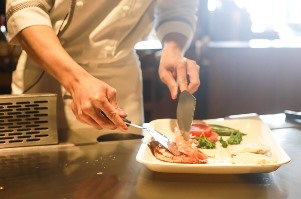Culinary Arts Courses
How to Choose the Right One Near South Valley New Mexico
 You have made a great career choice to become a cook or chef by enrolling in a culinary institute near South Valley NM. Not only will you learn how to cook extraordinary meals or prepare fancy desserts, you'll also be able to earn a good income doing it. However, just how do you undertake selecting a culinary arts school once you've made your decision to enroll? Prior to reaching your final selection, what requirements should you review and compare among the culinary schools you are considering? In order to be successful in the restaurant and hospitality industry you must select the right culinary program and degree. There are a wide variety of alternatives to pick from, starting with a certificate or diploma program and advancing to earning an undergraduate or even a graduate degree. You may attend a small culinary school, an online training class, or enroll in a large culinary institute that offers advanced degree programs. The type of credential and school you select will undoubtedly be based on the amount of time and money you can afford to commit, in addition to your ultimate career objective. Once you have decided what your main area of interest and budget are, you can begin assessing the cooking institutes that meet your preliminary requirements. Depending upon the certification and type of culinary school you select, you can be working as a professional chef or cook in as little as 6 months. So before we delve more into the process of choosing a school, let's talk a little more about the degree and culinary school options that are available.
You have made a great career choice to become a cook or chef by enrolling in a culinary institute near South Valley NM. Not only will you learn how to cook extraordinary meals or prepare fancy desserts, you'll also be able to earn a good income doing it. However, just how do you undertake selecting a culinary arts school once you've made your decision to enroll? Prior to reaching your final selection, what requirements should you review and compare among the culinary schools you are considering? In order to be successful in the restaurant and hospitality industry you must select the right culinary program and degree. There are a wide variety of alternatives to pick from, starting with a certificate or diploma program and advancing to earning an undergraduate or even a graduate degree. You may attend a small culinary school, an online training class, or enroll in a large culinary institute that offers advanced degree programs. The type of credential and school you select will undoubtedly be based on the amount of time and money you can afford to commit, in addition to your ultimate career objective. Once you have decided what your main area of interest and budget are, you can begin assessing the cooking institutes that meet your preliminary requirements. Depending upon the certification and type of culinary school you select, you can be working as a professional chef or cook in as little as 6 months. So before we delve more into the process of choosing a school, let's talk a little more about the degree and culinary school options that are available.
It Takes Just a Few Minutes to Start Your Culinary Arts Career Below!
Culinary Arts College Degree Options

As with many other industries or professions in South Valley NM, there are multiple degree options that are offered in the culinary arts. At the most basic level, you can sign up for a local cooking course, which are more casual in nature and can run from several hours to several weeks. Frequently a certificate or a diploma is offered after completion. They may be broad in nature, for instance demonstrating how to cook French meals, or they can be rather specific and focus on one dish, for example Crepes Suzette. Of course if you are searching for a more conventional education applicable for a career in the restaurant profession, you will undoubtedly want to enroll in a degree program. With a degree program, you will be required to commit considerably more time.
- Associate's Degrees can take anywhere from six months to 2 years to complete.
- Bachelor's Degrees normally entail as much as 4 years of training.
- Masters Degrees may take an additional 2 years or more after acquiring a Bachelor's.
More advanced educational options may be available, such as Doctoral or specialized programs made available by culinary arts institutes. Probably the most important issue to keep in mind when determining which degree to strive for is making sure that it provides the education and credential needed to advance your ultimate career goals.
Cooking Institutes

When you have made your choice regarding the type of instruction and degree that you would like to pursue, you can begin your search for the cooking school, college or institute that offers it. As an example, if your desire is to train to be a chef specializing in French cuisine, then naturally you will focus on those schools that furnish the appropriate training. Or you can pick an institute based on its reputation or other criteria (we'll discuss several of those later) and then pick the most suitable degree program available that is compatible with your career objectives in South Valley NM. However you arrive at your decision, cooking schools normally fall under three distinct categories:
- Cooking Schools. Certain cooking schools do offer degree programs, but generally they offer diplomas or certificates. Their courses tend to be more focused in nature, and they can last anywhere from one or two months to as long as three to four years.
- Community Colleges. Area community colleges tend to be more inexpensive than the majority of private schools and many have outstanding programs. They almost exclusively offer Associate's Degrees and are founded and maintained by either local or state governments.
- Culinary Schools and Institutes. The advanced degrees and training are provided by culinary arts colleges and institutes. A few institutes provide the most renowned and highest standard of training in academia. However, since they are private institutions they often can be more costly than their public counterparts, some a lot more.
Picking a culinary school will not only be dependent on the kind of program or degree you wish to pursue, but also how much you have to spend on your education. If you decide to attend a public institution to minimize costs, remember that out-of-state residents normally must pay a higher tuition than in-state residents. Furthermore, many community colleges and regional public schools have lower tuition charges for local residents. So don't forget to look into the public options within New Mexico as well as within the South Valley NM area to locate the most economical options.
Online Cooking Schools
 Many prospective students may find that there are no cooking institutes that are within travelling distance of their South Valley NM residence. One alternative is to attend online training within the convenience of one's home. The accessibility and flexibility makes it the single solution for some students that continue working full-time while attending school. Plus there are more programs online than ever before that are accredited. Bear in mind that a significant component of the instruction will be furnished through an externship. Externships are programs where students work with regional chefs or other culinary professionals to ensure that they receive practical training beyond the online classroom. Just be sure that the online program you enroll in is accredited by a U.S. Department of Education approved agency (more on this later). So if you are dedicated enough to be able to attend classes and study in this more independent manner, earning a cooking online degree may be the ideal choice for you.
Many prospective students may find that there are no cooking institutes that are within travelling distance of their South Valley NM residence. One alternative is to attend online training within the convenience of one's home. The accessibility and flexibility makes it the single solution for some students that continue working full-time while attending school. Plus there are more programs online than ever before that are accredited. Bear in mind that a significant component of the instruction will be furnished through an externship. Externships are programs where students work with regional chefs or other culinary professionals to ensure that they receive practical training beyond the online classroom. Just be sure that the online program you enroll in is accredited by a U.S. Department of Education approved agency (more on this later). So if you are dedicated enough to be able to attend classes and study in this more independent manner, earning a cooking online degree may be the ideal choice for you.
Comparing Culinary Schools
By now you should have made a decision regarding the type of degree that you want to attain, and whether or not you would like to enroll in a public or private school. Since there are numerous cooking institutions in the South Valley area and within the United States, you need to develop a checklist of important qualifiers so that you can begin narrowing your options. Certain obvious qualifiers, such as location and cost are a good place to start. But picking a school because it is the closest or the most affordable is not the best way to make a decision regarding your education. There are other criteria, for instance accreditation and reputation that you must assess also. Therefore, below are some crucial areas that you should research for every school as you compare and contrast them and make your final decision.
Accreditation. It's important that the culinary arts institute you pick has some form of accreditation from either a local or a national agency. As mentioned previously, the accrediting agency should be a U.S. Department of Education certified agency, such as the American Culinary Federation (ACF). ACF accredited schools have passed a detailed evaluation regarding their curriculum, instructors and facilities. So not only does accreditation help ensure that you will receive quality training, but it may also help in obtaining a student loan or financial aid which are frequently not accessible for non-accredited schools.
Age. Newer schools frequently have the benefit of having modern equipment and facilities. However, they may not have been operating long enough to garner an accreditation or to establish a reputation. Conversely, older schools may still be using their original, dated equipment, but have established a lengthy track record of excellence and obtained one or more accreditations. Also, the much more a school has been in business, the more alumni the school can reach out to for its job assistance program. Certainly there is some give and take dependent on the age of the culinary arts schools. And older, more reputable schools usually update their facilities and equipment. The valuable takeaway is that in the best case scenario, your school of choice will have an exceptional reputation, accreditation and a state-of-the-art facility with newer equipment.
Job Placement Rates. First off, ask what the graduation rates are for the cooking colleges you are looking at. Lower graduation rates are indicators that many students were unhappy with either the colleges or the programs and dropped out. They can also suggest that the instructors were not qualified to teach the course of study. Ask the schools to furnish their job placement rates also. If a school has a higher job placement rate, it will help confirm that it has a good or excellent reputation within the cooking community, in addition to a broad network of professional contacts. Be suspicious of any school that will not supply this information.
Location. The culinary arts institute that you choose must be within driving distance of your South Valley home, unless you have decided to relocate. You may consider attending college online, but you would still have to travel for your externship training. Alternatively, perhaps you have chosen to enroll in a particular culinary arts institute located in another state because of its prominence and programs offered. It would be a wise decision to check out the facility before enrolling, to make sure that you are satisfied with the area and your future living conditions. Inspect the training facilities in person to make sure they are up to date and that the equipment is state of the art. Remember also that a number of schools concentrate their job placement programs within their regional communities, so pick a location where you will be happy working.
Class Sizes. The most effective method to learn how to cook is with lots of one-on-one instruction. If the cooking school you enroll in has larger classes, you will undoubtedly get minimal personal attention from the teachers. The optimal means to evaluate the interaction between instructors and students is to attend several of the classes. Ask some of the students what their experience has been. Ascertain if they are happy with the amount of attention they receive in class in addition to the entire course of training. Also, talk with a couple of the instructors and find out what their teaching philosophies are together with their histories and qualifications.
Flexible Class Schedules. There is no point in enrolling in a cooking program if you will be unable to attend the classes. So make sure that the school you decide on offers class scheduling that will accommodate your busy lifestyle. If you can only attend at night or on Saturdays or Sundays near South Valley NM due to your job schedule, make sure that the school you decide on offers either weekend or evening classes. If you can only attend part-time, make sure that the culinary arts institute has a part-time alternative. Also, find out what the make-up policy is if you need to miss a class as a result of work, family or other responsibilities.
Find Out More About Culinary Classes in South Valley
Enroll in the Best South Valley Cooking School
A rewarding career in the hospitality and restaurant profession is predicated upon picking the ideal chef college. As we have addressed, there are various things that you need to take into account when comparing schools, including their accreditation, reputations, and training facilities. Just like any life changing decision, you should start by collecting information, and the ideal method to do that is by contacting culinary colleges directly, either face to face or over the phone. If you're unsure regarding which schools to check out, you may need to think about asking chefs in your city about any culinary colleges they endorse. Afterwards use the Web to look into these schools even more before you contact them. By making the effort to carefully research each of your education options, you will be in a better position to make an educated decision. And when you select the perfect school, you will have a terrific start toward your aspiration of becoming a chef in South Valley New Mexico.
South Valley Culinary Classes | South Valley Cooking Schools
